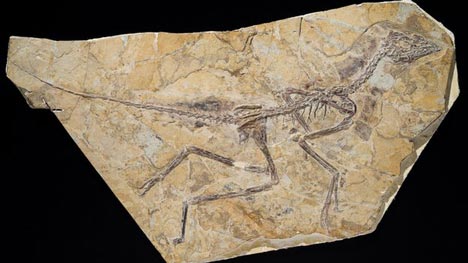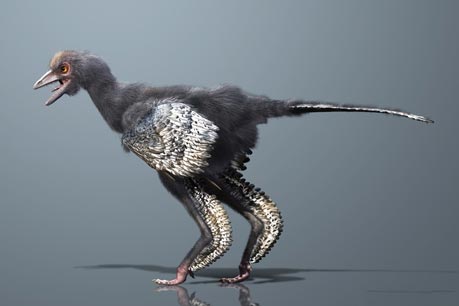Aurornis Discovery Restores Archaeopteryx to Its Perch
At one time feathered dinosaur fossils from the Jurassic and fossils of creatures identified as being Mesozoic birds, were as rare as “hen’s teeth”, however, the fine grained and fossil rich sediments of Liaoning Province (northern China), have changed all that. A substantial amount of fossil material of primitive birds and feathered dinosaurs has already been discovered and large numbers of specimens await further study in museum storage.
The Evolution of Birds
One such specimen, unearthed by a farmer, purchased by a local fossil dealer, sold on and in storage at the museum at the Fossil and Geology Park in Yizhou until last year, has helped scientists to re-write the bird/dinosaur lineage and re-established Archaeopteryx as a primitive member of the Aves (birds).
The half-metre-long specimen has been named Aurornis xui, the genus name means “dawn bird” and the specific name honours the famous Chinese palaeontologist Xu Xing, a scientist who has been at the forefront of research into feathered dinosaurs. Like many fossils from this part of China, the specimen was acquired through a fossil dealer. The dealer claimed that the specimen had been found in western Liaoning and that it came from the Tiaojishan Formation, which dates from 165 to around 153 million years ago. Tests on the rock confirmed this assertion and the authors of the scientific report, published in the journal “Nature” estimate the specimen to be around 160 million years old.
The Fossil Specimen (A. xui)
Picture credit: T. Hubin/IRSNB
Aurornis xui
The head of the animal faces to the right of the picture, the long tail and limbs can be clearly seen. The slight, discoloured (black/grey) staining above the base of the tail, along the back of the neck and at the front of the chest may represent evidence of the presence of feathers.
There are a number of primitive skeletal features present, along with traces of feathers on the long tail, neck and chest. The research team, headed by Pascal Godefroit from the Royal Belgian Institute of Natural Sciences have placed Aurornis at the base of the Avialans, a group that includes true birds and their close relatives since the divergence away from the Dinosauria.
An Artist’s Impression of Aurornis xui
Picture credit: Masato Hattori
Furthermore, the research team carried out an in-depth phylogenetic analysis of bird/dinosaur specimens which has led them to conclude that Archaeopteryx, once placed outside of the Aves and regarded as not being part of the Aves evolutionary lineage, should be re-assigned and placed back with the birds.
The first fossils of Archaeopteryx (A. lithographica) were found in the 1850’s and in 1861 a beautifully preserved almost complete specimen was unearthed. Here was a creature from the Upper Jurassic strata of Solnhofen (Germany) that had feathers, skeletal features which resembled birds, but also with teeth, claws and a long tail.
A Transitional Form
The specimen seemed to be a transitional form between reptiles (Dinosauria) and birds. However, feathered fossil finds from Liaoning Province had led a number of scientists to re-assign Archaeopteryx and place it in a less pivotal position on the evolutionary path towards true birds. This re-classification of Archaeopteryx, placing it within the Dinosauria Order rather than with the birds, implied that powered flight must have evolved at least twice amongst different, but related types of creature.
The evolutionary line to the true birds evolved powered flight and thanks to this re-assignment of Archaeopteryx fossil material, a form of convergent evolution must have occurred with a evolutionary line of bird-like dinosaurs evolving powered flight too.
Archaeopteryx an Ancestor of True Birds
The discovery of Aurornis xui coupled with this new analysis of the fossil material has simplified the picture somewhat. Archaeopteryx is once again considered an ancestor of true birds, implying that powered flight evolved only once, on the dinosaur to birds evolutionary line. The analysis undertaken by Dr Godefroit and his fellow researchers was much more comprehensive than previous phylogenetic studies, the doctor commented:
“Previous phylogenetic investigations were based on maybe only 200 morphological characteristics. Here, we recognise almost 1,500 characteristics. So it’s a much bigger and more robust analysis, and according to this new investigation Archaeopteryx is again considered an ancestor of birds and the new creature we describe is also a basal bird; and in fact it is even more primitive than Archaeopteryx.”
This new research places Archaeopteryx, Aurornis and the genus known as Anchiornis (discovered in 2009) at the base of the Avialae lineage that would give rise to the true birds.
To read an article about the implications of the discovery of Anchiornis: In a Flap over Feathered Fossil Discoveries from China.
This scientists state that Aurornis xui was very probably incapable of powered flight. It could have been a glider as its feathers were not the contoured, complicated pennaceous flight feathers seen in extant birds.
This new analysis of the known fossil material has implications for a number of genera once classified on the Dinosauria side of the dividing line between dinosaurs and birds. The fossils of a number of members of the Troodontidae, a family of bird-like dinosaurs have also been re-examined. The cursorial predator known as Balaur bondoc, a bizarre, highly specialised, Late Cretaceous carnivore from Romania (Hateg Island), which resembled Velociraptor has been placed within the Avialae. Like Aurornis, Balaur bondoc could not fly unlike the rest of the Avialae, so far assigned.
To read an article about the discovery of Balaur bondoc: Stocky Heavyweight Dragon from Romania.
The wider implication for this research is that if powered flight only evolved once in the Dinosauria, then feathers most certainly evolved initially for other functions, flight was a later, secondary consequence of the evolution of modified scales that eventually become feathers. Feathers may have first evolved as visual communication devices, to show status in a pack structure or hierarchy, or to help brood eggs during the nesting season.
Commenting on the implications of this new research, co-author Gareth Dyke from the National Oceanographic Centre (Southampton, England) said:
“Still, it’s unlikely that this is the final shake up in birds’ early history. As more fossils are found in this unexplored age, these relationships are going to change – it’s currently in a great amount of flux.”
A spokesperson from Everything Dinosaur stated:
“The evolution of the bird lineage is far from fully understood. It is very likely that more fossil material is in storage yet to be studied in detail and there may be many significant specimens in the hands of private collectors that could add to our understanding regarding the divergence of the Dinosauria and the evolution of powered flight.”
To view models of theropod and other dinosaurs: Wild Safari Prehistoric World Figures.







Is this bird earlier than Archaeropteryx?When I first saw it I thought it was a dromaeosaurid.I think an Archaeropteryx model manufactures by Safari Ltd would be really good.Goodbye.
Aurornis is known from just a single specimen. We have not seen the data but if it is assumed that it is from the Tiajishan Formation of western Liaoning then it probably does pre-date A. lithographica. We do make a point at the end of the article about there being the strong likelihood that there are a lot more fossils awaiting study that will shed more light on the evolution of the Aves. As is stands, Aurornis is more primitive than Archaeopteryx in terms of evolutionary traits for powered flight. The line between Dromaeosauridae and Aves is very blurred. It would be great if Safari Ltd made an individual model of Archaeopteryx, although we think that there is an Archaeopteryx model within the Feathered Dinosaur Toob from Safari Ltd. Thanks for your comment.
Thank you for answering.Juan Andrés